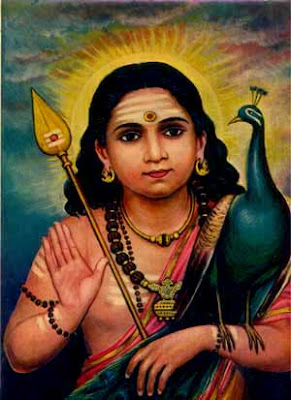
Âlatti Pûja, Kataragama Mahâ Dêvâle
In the dry jungle of remote southeastern Sri Lanka lies Kataragama or Katir-kamam, the (place of) "light and love-passion," a shrine complex of exceptional antiquity and sanctity that attracts many thousands of Buddhist, Hindu, and even Muslim devotees.
They come year round, particularly during the fortnight-long Aesala Festival in July-August. It is at this time that a small casket believed to contain the secret of the god's birth -- some say the god himself -- is taken out in a solemn, yet joyful, torchlit procession nightly. It is escorted by his female-votaries and troupes of riotous dancers. The latter represent the animal, human, chthonic, and heavenly spheres.
An archaic spirit of paradox, fertility, rejuvenation, and play, the Kataragama god also preserves an essential soteriological dimension as the Divine Psychopomp. He guides his followers beyond the Portals of Death into an unconditional realm of freedom from the tyranny of the pairs of opposites.


Sri Jñâna Pandita: Murugan as Expositor of Gñosis with His symbols the Vêl or Spear of Wisdom = axis mundi and vehicle/totem the peacock = Phoenix. Behind Him dawns the rising sun symbolizing the awakened mind (bodhi). Early 20th cent. painting by NS Balakrishnan, Madurai.
A host of local indigenous, Sinhalese [Buddhist], Tamil [Hindu], and Islamic legends purport to explain the origin, character, and exploits of the Kataragama god. His reputation for sacred or mysterious power extends far beyond his immediate forest domain however.
Broadly speaking, scholars, and cult-adherents alike identify him with the ever-popular Tamil hill god Murukan ("Tender One"). This god is said to have arisen before the dawn of history and has long been considered as the Dravidian counterpart or expression of the pan-Indian war god Skanda-Kumara, "son" of the great mountain-dwelling god Shiva.
Skanda -- tutelary god of warriors, kings, yogis, scholars, and (as Guha, "the Hidden") patron of all secret knowledge and covert activities -- once quit his home on Mount Kailasa in the trans-Himalaya and, according to various traditions, made his way south in a series of exploits culminating at Kataragama. He engaged in a secretive courtship and marriage to the indigenous Vedda maiden Valli, which is the... More>>
Gods of Feminine Power
.
...Of particular interest, however, is the god's longstanding association with the number six and the shatkona yantra or "six-cornered magical diagram." For the shatkona yantra (etched upon a metal plate) is precisely what is believed to be contained in the small casket that is taken out in procession at Kataragama.
.
A full discussion of the subject of the "calculus" of symbolic forms goes beyond the scope of this article. Suffice it to say that the god, whose Sanskrit name Shanmukha (Tamil: Arumukam) means "having six faces," is homologized to the hexagram: a figure composed of two intersecting equilateral triangles representing the mother-principle and the father-principle in balanced union. From this there is the Holy Child known to mythologies all over the world.
.
In the traditions of Europe and West Asia, the hexagram is well known as the "Seal of Solomon." This alludes to its widespread association with the conjunction of sacerdotal authority and temporal power.
.
Moreover, the yantra in conjunction with the vel or spear corresponds to the archetypal warrior's shield and spear or, in another context, to the axis mundi and the chakra (wheel) or loka (plane of existence) through which the axis mundi or "solar ray" passes as an axle around which a wheel turns.
The yantra is another product of India's indigenous, non-discursive schools of ritual magic. As such it is intended not merely for decorative purposes but for its magical efficacy. Its etymology offers a clue to the yantra's function and reason for being.
.
Like the similar terms mantra and tantra, it consists of a verbal root yam ("to hold") plus the suffix -tra denoting instrumentality. Hence, ya(m)-tra or yantra, "a device that holds," that is, a magical snare, trap, or container -- especially one designed to hold a spirit, demon, or god (deva).
.
In this function, the yantra parallels the pervasive South Indian pattern of place-goddesses (e.g. Madurai Meenakshi Amman or Valli Amman of Kataragama) who first attract and then "hold" wandering gods to those places as their husbands.
.
In the context of Kataragama, the yantra in the holy of holies may be understood to "hold" or "contain" the god of six faces or directions. This is what the Ark of the Covenant was understood to "contain," namely, the Shekinah or "presence" of the Holy Spirit of god Jehovah....
More

































































































































































































































No comments:
Post a Comment